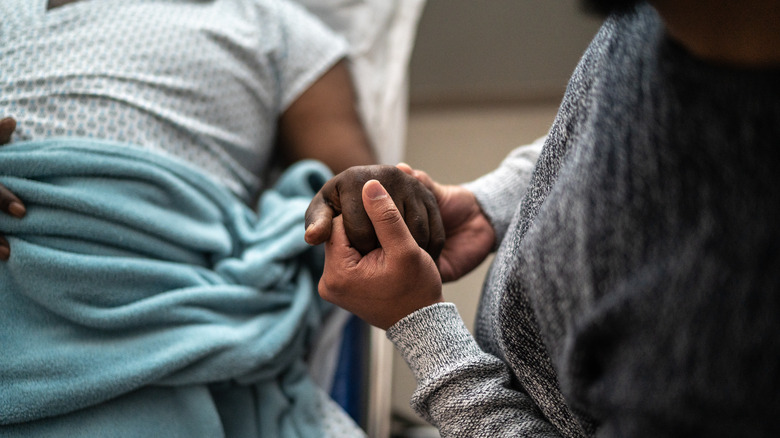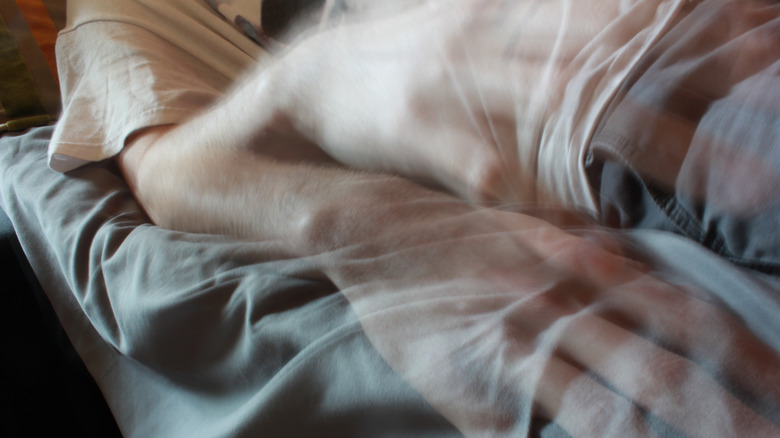Weird Things People See When They Have A Near-Death Experience
There is nothing that divides a room as much as the topic of near-death experiences. When science, spirituality, and the great unknown clash, people are often left wondering about existential questions like, "Is there such a thing as an afterlife?"
Psychiatrists and other health professionals have long been interested in what people see and hear before they die. According to a 2017 study, there are some weird things people see and experience when they have a near-death experience: a feeling of peace, a bright light, traveling through a tunnel, out-of-body experiences, and seeing ghosts before death. By analyzing written accounts from 154 people who were close to death, researchers in Belgium attempted to map out a sequence of sightings and experiences. They found that 80% of the subjects recalled feeling a sense of peace, 69% saw a bright light, and 64% saw spirits. There were participants who spoke of leaving their bodies and returning back to them, others who discussed precognitive visions, and yet others who talked of racing thoughts, per Science Daily.
When it came to sequencing, out-of-body experiences seemed to most frequently occur first, according to neuropsychologist and study author Charlotte Martial (via Science Daily). "This suggests that near-death-experiences seem to be regularly triggered by a sense of detachment from the physical body and end when returning to one's body," she explained.
Out-of-body experiences might be caused by damage to an important part of the brain
Even in a 2023 study on 28 cardiac arrest survivors, floating atop their own bodies and having an out-of-body experience seemed to be a common theme. These subjects also spoke of seeing a bright light, going through a tunnel, engaging with a family member, and feeling intense emotions of love and peace during their near-death experiences, per NBC News.
Neuroscientist Dr. Jane Aspell told the Daily Mail that the near-death experience of being detached from your body may have to do with damage to the temporal parietal junction, the part of the brain that processes senses and balance and contributes to a feeling of self inside one's body. "It seems to make sense then that if this area is not functioning as it should, this integration of all of these different signals will not occur as it should, so the experience of being one single body might therefore be disrupted," explained Dr. Aspell.
While we might not know exactly what happens before the final moments of death, researchers seem to think that what people see during near-death experiences, weird as they might be, changes them.
What people see during near-death experiences is often more vivid than real-life memories
Researchers say that the memory of what is seen during near-death experiences tends to be more vivid than even real-life memories. According to Dr. Bruce Greyson, a professor emeritus of psychiatry and neurobehavioral sciences at the University of Virginia who has long been interested in near-death experiences, there is a distinct sense of clarity in vision and sound when people experience near-death experiences (via The U.S. SUN).
A 2013 study that compared real-life memories of coma survivors and what they experienced during near-death experiences found a marked difference in their clarity. "To our surprise, NDEs were much richer than any imagined event or any real event of these coma survivors ... The difference was so vast ... Sometimes, it is hard for them (the patients) to find words to explain it," Dr. Steven Laureys, a Belgian neurologist and author of the study, told CNN Health.
People who have gone through near-death experiences are also said to feel transformed afterward. "They say they have lost fear of death, because they know that life continues," shared Jim Tucker, a psychiatry professor at the University of Virginia who studies near-death experiences in children (via Business Insider). It seems the topic of what people see right before they die is ever-evolving, as is the science behind it. Perhaps further research will yield more answers.



